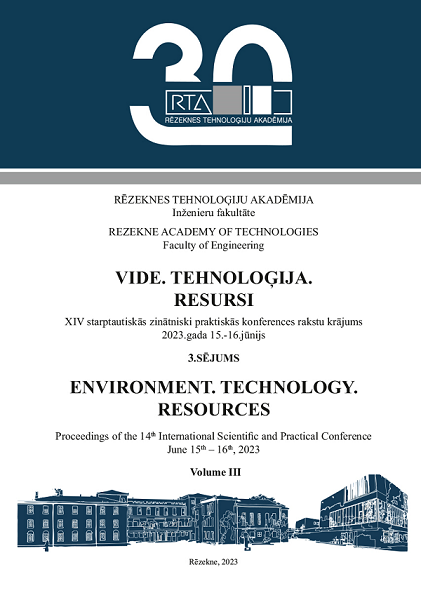CONVEYOR-TYPE SMALL HYDROPOWER PLANT FOR SHALLOW RIVER WATERS
DOI:
https://doi.org/10.17770/etr2023vol3.7229Keywords:
dynamic analysis, flat blades, hydropower plant, optimizationAbstract
This paper deals with the development of a small conveyor-type hydropower plant intended for operation in shallow river waters without construction of a dam. The proposed design offers a closed-shaped flattened conveyor equipped with flat-shaped blades. The conveyor is oriented perpendicular to the fluid flow. Several identical flat blades interacting with fluid flow are mounted on conveyor belt and move together with the belt in one straight line direction. Then after turning in the reversing mechanism, blades move in the opposite direction. The conveyor system has a built-in energy generator which drive shaft is connected with one of the reversing ends of the plant. Conveyor belt system dynamics analysis is performed on the base of equivalent model with one degree of freedom. The interaction of a moving conveyor flat blade in translation motion with fluid flow is studied by computer simulation with program Mathcad using a superposition principle. In accordance with this approach, a fast-chaotic motion of fluid particles (Brownian motion) is separated from the slow-directed flow motion, with the given average velocity. Optimization of system parameters (blade orientation angle to fluid flow, interaction constants of the braking generator) is performed, using a generated power as criterion. Simulation results confirm the serviceability and operational efficiency of the proposed hydropower plant in shallow river waters.
References
International Commission of Large Dams, “World Register of Dams. General Synthesis”, updated April 2020. [Online]. Available: ICOLD CIGB > General Synthesis (icold-cigb.org). [Accessed: Feb. 20, 2023].
E. P. Anderson, M. C. Freeman, and C. M. Pringle, “Ecological consequences of hydropower development in Central America: Impacts of small dams and water diversion on neotropical stream fish assemblages”, River Research and Applications, vol. 22, no. 4, pp. 397–411, May 2006, https://doi.org/10.1002/rra.899
J. Geist, “Editorial: Green or red: Challenges for fish and freshwater biodiversity conservation related to hydropower”, Aquatic Conservation: Marine and Freshwater Ecosystems, vol. 31, no. 7. John Wiley and Sons Ltd, pp. 1551–1558, July 2021, https://doi.org/10.1002/aqc.3597
C. M. Bunt, T. Castro-Santos, and A. Haro, “Performance of fish passage structures at upstream barriers to migration”, River Research and Applications, vol. 28, no. 4, pp. 457–478, May 2012, https://doi.org/10.1002/rra.1565
Ambra Giovannelli, “Development of turbomachines for renewable energy systems and energy-saving applications”, Energy Procedia, vol. 153, pp. 10–15, October 2018, https://doi.org/10.1016/j.egypro.2018.10.069
J. Viba, V. Beresnevich, S. Noskovs and M. Irbe, “Investigations of rotating blade for energy extraction from fluid flow”, Vibroengineering Procedia, vol. 8, pp. 312–315, October 2016, https://www.extrica.com/article/17667
J. Viba, V. Beresnevich, M. Irbe and J. Dobelis, “The control of blades orientation to air flow in wind energetic device” Energy Procedia, vol. 128, pp. 302-308, September 2017, https://doi.org/10.1016/j.egypro.2017.08.317
C. Boller, M. Buderath, “Fatigue in aerostructures – where structural health monitoring can contribute to a complex subject”, Philosophical Transactions of the Royal Society A, vol. 365, no. 1851, pp. 561-587, February 2007, https://doi.org/10.1098/rsta.2006.1924
J. Viba, V. Beresnevich and M. Irbe, “Synthesis and Optimization of Wind Energy Conversion Devices”, in Design Optimization of Wind Energy Conversion Systems with Applications, Karam Maalawi, Ed. London: IntechOpen, 2020, pp. 125-141, http://dx.doi.org/10.5772/intechopen.90819
I. Tipans, J. Viba, M. Irbe and S. K. Vutukuru, “Analysis of non-stationary flow interaction with simple form objects”, Agronomy Research, vol. 17, no. 1, pp. 1227-1234, 2019, https://doi.org/10.15159/AR.19.083
J. Viba, V. Beresnevich and M. Irbe M. “Methods and devices for wind energy conversion”, in Wind Turbines - Advances and Challenges in Design, Manufacture and Operation, Karam Maalawi, Ed. London: IntechOpen: 2022, pp. 247-270, http://dx.doi.org/10.5772/intechopen.103120
J. L. Meriam, L.G. Kraige and J.N. Bolton, Engineering Mechanics: Dynamics. New York: John Wiley& Sons, 2016.
G.E.M. Beshay and K.Y. Maalawi, “Structural Optimization of Wind Turbine Blades for Improved Dynamic Performance”, in Design Optimization of Wind Energy Conversion Systems with Applications, Karam Maalawi, Ed. London: IntechOpen, pp. 69-107, 2020, http://dx.doi.org/10.5772/intechopen.91643



